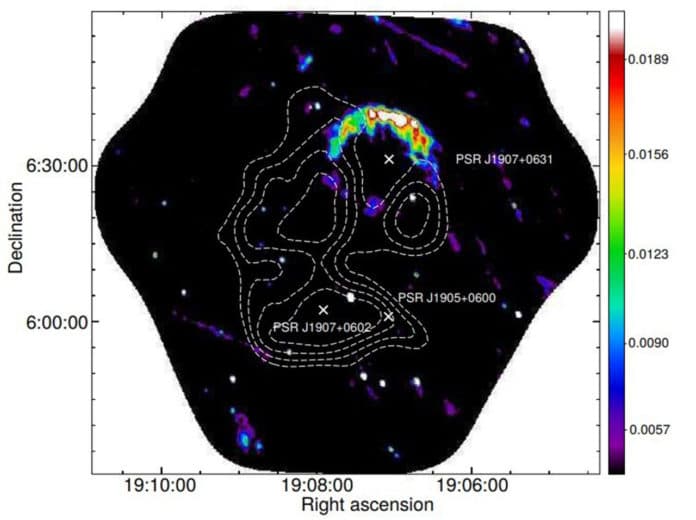The TeV source VER J1907+062, primarily observed in 2007, is an example of the so-called very high energy (VHE) γ-ray dark sources, which are detected in the VHE range but do not have a clear counterpart at other energy bands.
Past investigations have shown a strong TeV emission from this source near the location of the pulsar PSR J1907+0602, extending toward the supernova remnant SNR G40.5−0.5.
The nature of VER J1907+062 is as yet obscure. Based on strong TeV emission around PSR J1907+0602, some astronomers suggest that this source could be a TeV pulsar wind nebula (PWN) powered by this pulsar. Additionally, it was likewise recommended that VER J1907+062 might be the superposition of two sources, either separated or interacting.
To shed more light on the origin and true nature of VER J1907+062, a team of astronomers has carried out new high-quality radio observations of this source using VLA.
They presented new high-quality radio images of a vast region containing the extended TeV source VER J1907+062 at 1.5 GHz and a region toward the PSR J1907+0602 at 6 GHz, in both cases with data obtained using the VLA in its D configuration.
Scientists didn’t detect any nebular radio emission toward PSR J1907+0602 or the other two pulsars in the region. What’s more, the images didn’t show any evidence of extended radio emission in coincidence with PSR J1907+0602. Also, there was no evidence of extended nor point-like emission toward the pulsar.
In other words, the results disapprove of the scenario suggesting that the non-thermal X-ray emission around the pulsar may be a PWN.
The research found molecular clouds in the vicinity of SNR G40.5−0.5, which match the eastern, southern, and western borders of the remnant and partially overlap peaks of the TeV emission from VER J1907+062.
According to scientists, there is an association of the studied TeV source with this SNR.
Summarizing the outcomes, astronomers proposed two hypotheses that could clarify the origin of VER J1907+062.
According to them, this source could be the superposition in the line of slight of two distinct gamma-ray sources powered by various emission mechanisms and located at different distances. They discover this situation as the most conceivable; however, don’t exclude the possibility that VER J1907+062 could be a single source whose VHE emission is produced by two-particle accelerators (the pulsar and the supernova remnant) situated at the same distance.
Results of the study, published December 27 on arXiv.org.
